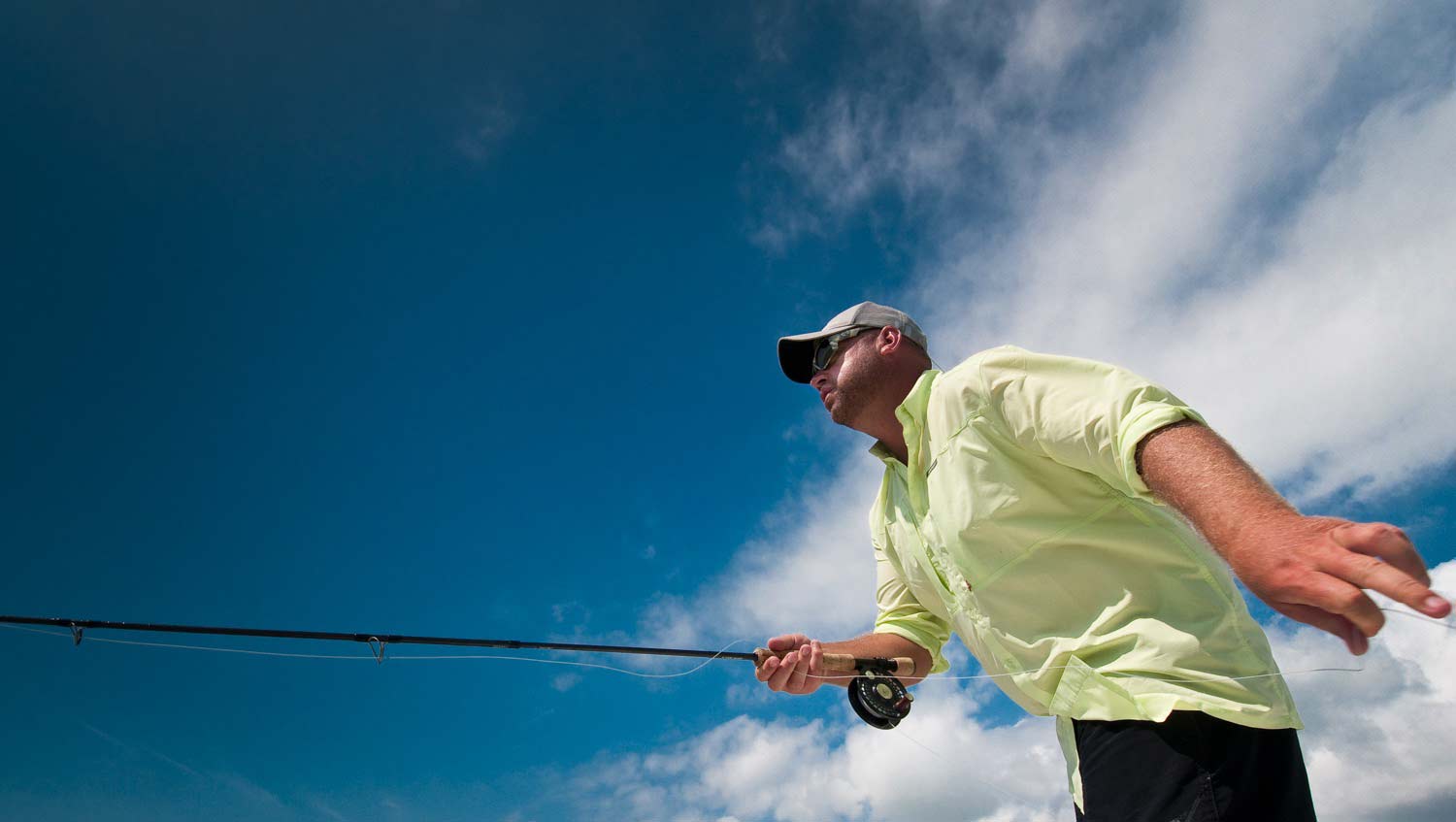
Photo by Louis Cahill
By Louis Cahill
Fly casting in the wind is just fly casting…in the wind.
“Ok, so I’m in my ready position, and the wind is blowing on my right side…”
The question came from an angler at this year’s January Bonefish School. I didn’t need to hear any more of it.
“I’ll stop you right there,” I replied, “The answer is, stop thinking about the wind.”
I vividly remember being in that mindset. Freaked out about the wind, overthinking stuff that had nothing to do with getting the fly in front of the fish, rushing my cast and melting down on the bow. It’s a terrible feeling. I see other anglers give up completely, either on the bow or back at the lodge with a book. The fact is, is you are going to fish saltwater, you’re going to have to cast in the wind and the sooner you make piece with it, the more fish you’ll catch.
I get asked all the time how to cast in the wind. Maybe more than I get asked anything else. Here’s the answer. There’s a secret to casting a fly rod in the wind. From the looks I get when I tell folks, I’m guessing it’s a well kept secret. The secret is, you cast exactly like you cast when there’s no wind.
The techniques for casting a fly in the wind are exactly the same as casting on a calm day. The difference is that the wind does not forgive poor technique. Sure, there are some helpful tricks you can use, like a Belgian Cast when the wind is off your casting shoulder, but that’s specialized stuff and if you are struggling with the wind, it isn’t really an answer. If you are struggling with the fundamentals of the cast, advanced technique you haven’t practiced is’t going to help any more than striking a Bruce Lee pose in a bar fight. You’re likely just going to get your ass kicked extra hard.
The most helpful thing you can do on a windy day is forget about the wind.
 For most anglers the problem isn’t that they don’t know how to cast in the wind, but when the wind blows, they forget hoe to cast. This is the voice of experience. I was in that camp for years. I remember when the light finally turned on. It was a revelation. Casting in the wind is just casting without losing your composure.
For most anglers the problem isn’t that they don’t know how to cast in the wind, but when the wind blows, they forget hoe to cast. This is the voice of experience. I was in that camp for years. I remember when the light finally turned on. It was a revelation. Casting in the wind is just casting without losing your composure.
Disclaimer: If you don’t understand the fundamentals of the fly cast, well, you need to. You can’t Zen away ignorance. Start with The 5 Essentials Of A Good Fly Cast Revisited, and practice. For those of you who can make a nice cast when it’s calm but fall apart in the wind, here are some practice tips.
Some Dos and Don’ts forecasting in the wind.
Don’t rush your cast
Most angler try to generate line speed in the wind by casting harder. Usually the first thing to suffer, or disappear all together, is the pause at the end of the stroke. Your fly line is weighted to load the rod. If you don’t let it straighten out, you can’t get a good load and you have no power in the cast.
Don’t drop your rod tip
The other effect of casting harder is usually dropping the rod tip. In an effort to make a longer stroke the rod tip comes off a straight line path, causing the line to crash down on the water and the leader to pile up.
Stop the rod hard and high
The stop at the end of the stroke is what forms the loop. Stopping the rod high and hard makes a tight energized loop that cuts the wind.
Keep the rod in the stopped position
Most anglers drop the rod too early on their presentation. In general, I believe in keeping the rod in the stop position until the loop unrolls to the leader, then I drop the rod as the leader unrolls. Keeping that anchor point keeps the energy in the loop. On a windy day you don’t have to worry about being delicate. You can hold the stop position until the fly hits the water.
Put the power in the backcast
The best way to have a powerful forward cast is to have a powerful backcast. This may sound counterintuitive, but if you make a powerful backcast, then come forward nice and easy you’ll get more power in the cast.
Haul the fly into the water
Normally I like to shoot the fly to the fish. If it’s really howling, I keep the tension in the line all the way. I work out all the line I need, then haul and hold the line as the fly is delivered.
Use your backcast presentation
If the wind is off your casting shoulder, you could use a Belgian Cast, but it’s easier and more effective to use a backcast presentation. You’ll want to practice this ahead of time if you aren’t confident in it.
Put the power in the haul
Rather than putting extra power into your casting stroke, almost always a disaster, put it into your haul. You’ll get more line speed and keep a clean tight loop. Here’s a video that will help.
The most important thing when casting in the wind is, don’t let it get in your head. Focus on good casting basics and don’t try to invent a new cast. Make fewer mistakes and you’ll get better results. I hope this helps you get the fly to some awesome fish!
Louis Cahill Gink & Gasoline www.ginkandgasoline.com hookups@ginkandgasoline.com Sign Up For Our Weekly Newsletter!
Very good advice, much of which I forget to take when the wind is really howling. A couple other suggestions (probably learned from earlier G&G articles) are to not let the rod completely load and unload on the back cast and forecast because the wind will blow your final presentation off line. When it’s calm, you can wait for the tug on the back cast. When it’s windy, keep the rod under tension the whole time. The other suggestion is to cast 3/4 or almost sidearm as it’s often calmer nearer the surface than if you’re casting at 11 O’clock.
I find that lowering my shoulder on the forward cast really helps a lot in the wind. It was the one tip I’ve gotten that really works for me.
Nice to see you back in Action Louis!
Spectacular form. Excellent explanation and demotration.
Kudos